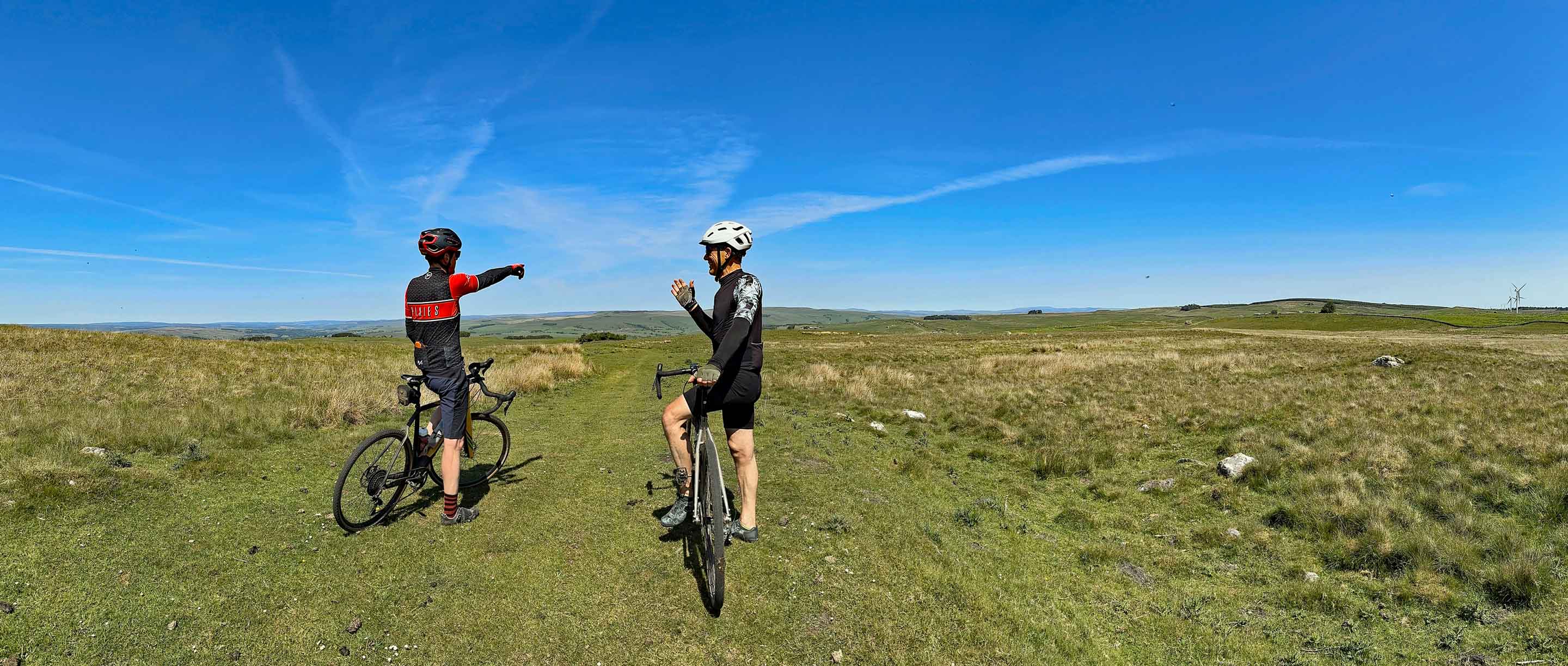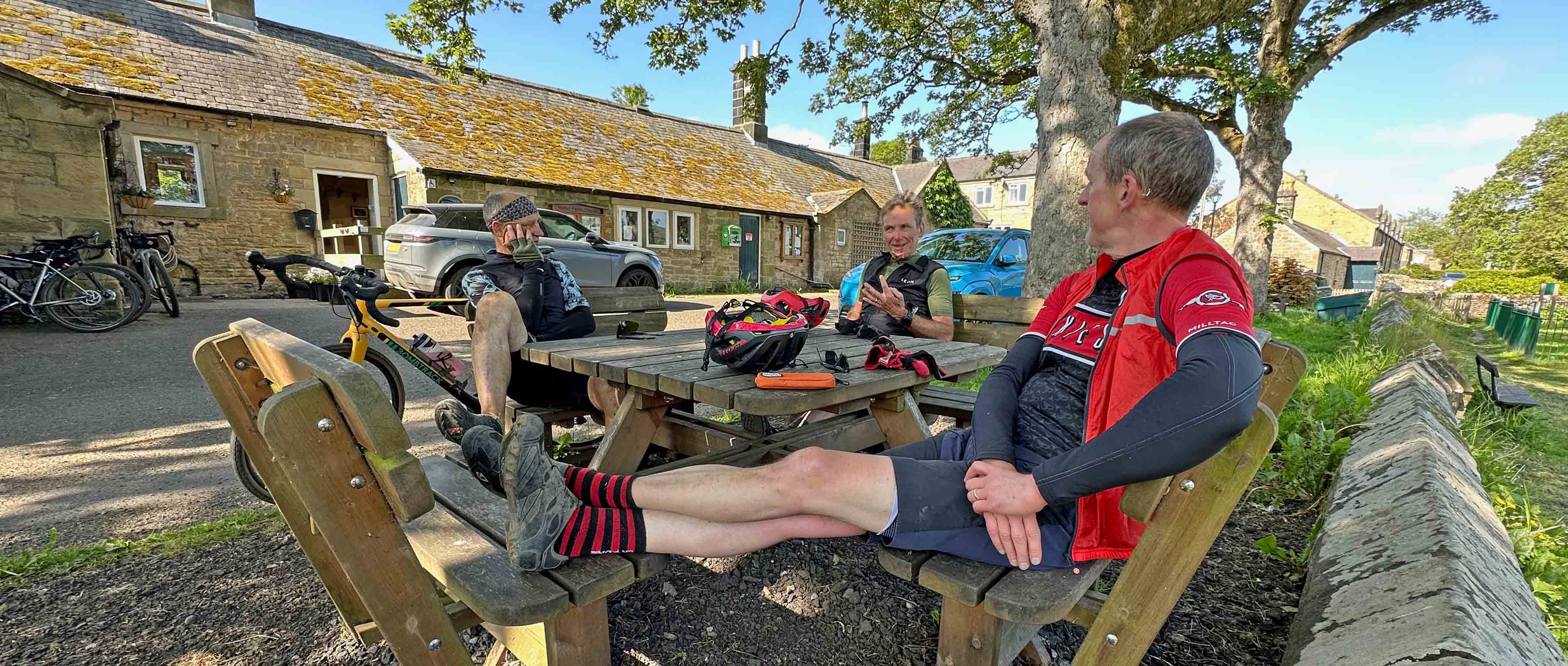Although having a pre-determined target distance as the creative spark behind a gravel ride might seem a little arbitrary, it can also lead to a spectacularly fun day out on the bike. Olly took inspiration from a world-famous US gravel event and headed out into the wilds of Northumberland in search of summer gravelling.
“What colour zip-tie would you like?” asked Rob, producing a selection, neatly bound together with an elastic band. Rob had already produced a crank endcap removal tool and a chain quicklink splitter, so by this point I wasn’t that surprised that he was also proffering a choice of zipties to colour coordinate with my bike.
Having to remove the chainset and front mech from my bike isn’t generally something I would want to be doing in the middle of a 100mile gravel ride, but mechanical gremlins don’t pay any heed to your distance goals for the ride and sometimes, no matter how much preparatory maintenance you do, they still come and pay you a visit.
Luckily, with the aid of Rob’s spectacularly well kitted out frame bag, we were soon rolling again. Ok, so I now had to do manual front shifts (by stopping and using my hand to change chainrings) but that was still preferable to the alternative scenario of having to ring my wife and ask to be collected mid-ride.
In some weird way, maybe this was karma. A few hours earlier I’d been patching up Rob’s face after his field testing of a prototype chin-braking system had proved slightly more successful than he had hoped for. Now I was calling on Rob’s impressive pre-ride planning and using his trail tools to repair my ailing bike. Rob’s unscheduled meeting with terra firma came early in the ride and had caused us some consternation. “I’m dripping blood onto my toptube bag” is not a phrase you really want to hear from one of your ride buddies. Fortunately, it seemed his injuries looked worse than they actually were, although we continued to check on him throughout the remainder of the ride.
Luckily, both Rob’s chin and my bike went on to make a full recovery.

As rule, I don’t give much thought when I’m designing a route to exactly how long it is. My route planning is based on the quality of the trails, geographic locations, wind direction, cafe opening hours and group preferences for doing a certain ride. The distance is merely a happy coincidence of all those variables added together.
But for today’s ride, our number one goal was to ride 100miles/160.something kilometres with as many off-road trails as possible. In theory we should have started riding at 6am and not made more than two feed stops, but we might have glossed over that bit of the rules. It was supposed to be fun after all!
So why we were following such a seemingly arbitrary set of rules you might ask? Because we were taking part in Rebound2023 is of course the answer. Rebound, the brainchild of professional gravel racer Laurens ten Dam, is the ‘localised’ version of the Unbound, the daddy of all gravel races in the USA. Rebound was planned to be a geographically dispersed version of Unbound, where the aim was to replicate some of the unique characteristics of the race, but without the massive carbon footprint of flying to the mid-west USA to take part in the actual event.

I started talking to my friends in the #fridaygravelgang about doing Rebound months ago. At the time, our local gravel trails were literally underwater in places and the thought of riding 160kms on them seemed distinctly unappealing. After one of the wettest winters in the last decade I began to feel quite pessimistic about the big day and was starting to consider Plan B. Fortunately, just when I was giving up all hope, the weather gods decided to play nicely and for the two weeks before D-Day (3rd June) we had the perfect combination of weather conditions - dry, mainly sunny and quite windy.

With spring also running absolutely flat out, the combination of improved weather and the local flora sucking up every drop of water they could get their hands (leaves?) on, the trails went from appalling to astounding in the course of about 10 days. Suddenly even the foulest stinking puddles and swampiest of boggy sections seemed to dry up and then when I saw the long term forecast for the few days running up the event, essentially blue and sunny every day, I began to put Plan B back on ice and started looking forward to Plan A again.

I’d been working on a route which headed south from our home city of Newcastle and took in as many of the hills and moors of the Northumberland/County Durham border area as I could. Unlike Unbound, my route was not going to stick to “just” gravel trails. In fact, riding 100miles of vehicle-width gravel road really has no appeal to me at all, so my route would have some sections of singletrack, some rocky descents, a sandstone bedrock climb, lots of forest trails and as much hardpacked grassy moorland trail as I could shoehorn in. I had planned in three stops, plus I had a couple of shops on standby close to the route just in case. And, an obligatory nearly-but-not-quite-finished beer stop before we arrived back home.

Then a few days before the big day, our WhatsApp group chat pinged with the arrival of a message from Barry, suggesting an alternative route, which headed west rather than south. I knew most of the trails he was suggesting, but crucially (and what hooked me in) was that right in the middle of Barry’s route was a long section that was totally new to me. Barry had ridden it all before and really rated it as a route. All it needed was a bit of tweaking to bring it up to the magic 100mile mark and we were all set.

Fresh faced, with chins all still in pristine condition, we met at a chilly, but sunlit 7.30am and headed out on our big route. Taking in some super fun, but slightly contrived urban trails meant we had some climbing to do to get away from the city (and to crucially help us meet the 100-mile goal). Unlike the real Unbound, our route included some quite technical riding almost straight away and our trails were so dry that we kicked up dust plumes, even on the first climb. As is pretty typical when heading out in the countryside from an urban meet-up point, our route contained a mix of off-road and on-road riding, with the eventual proportion being 60% paved/40% unpaved.

In my pre-ride planning, I’d looked into potential café stops but had discovered that the first of them wouldn’t be open due to the early hour at which we would be passing. Fortunately, as we rode close to the café anyway, we called in and discovered that their web and social media presence displayed the wrong times and they were actually open, so we had our first coffee outside in the sunshine. With all of the morning’s riding scheduled to be on known trails, we made good time and arrived at another café for an al fresco lunch. The waitress pulled a slightly shocked expression when she saw the damage to Rob’s face and immediately offered the use of their first aid kit, assuming he was freshly ‘damaged’. When we explained it was by now quite an old wound and was healing nicely, she instead bought out some damp paper towels to help him remove some of the dried-on blood.
Lunch inhaled and a short, sun lit section of tarmac dispatched we headed into the unknown (for me at least) with a long section of forest road, cutting a lonely path through the south-eastern edge of the monumental Kielder Forest. This was the section which most closely resembled the trails of Unbound with fast, rolling terrain and vehicle width trails. The period of good weather before our big day meant everything was bone dry and warm enough that you could smell pine resin in the air every time we passed a pile of cut timber.
Our next destination was a date with a history, as we crossed over Hadrian’s Wall, described as “the largest Roman archaeological feature in Britain”. The wall, which runs a total of 73 miles (117.5 kilometres) was constructed to separate Roman Brittania from the unconquered lands of Caledonia to the north. Crucially for us, it also provided the location of a mid-afternoon tea stop and water fill up point.
The remainder of the afternoon’s route initially followed more vehicle width gravel trails, but as we neared home we added in some sections of much more technical singletrack, including two short steep climbs. The primo trail conditions meant we managed to ‘clean’ the second (and harder) of the two climbs – a feat not generally accomplished, as they always fall late in the ride and the combination of tired legs and fogged brains never aids climbing prowess.
“Are you sure it’s going to be 100 miles?” asked Clive, as he peered at his bike computer and tried to do the mental calculation of how far he estimated we had left to ride, versus what his computer said we had already ridden. I’d been pretty meticulous in my planning and had built in a small margin for error for too, but I did have a mental wobble at the thought that we might come up short on our planned target distance.
Fortunately, as we rolled along the final section of traffic-free riverside trail, we ticked off the requisite additional distance and arrived at the point where our routes diverged for our respective homes, meaning we all arrived home having clocked just over 100miles.
While we didn’t play strictly by the Unbound/Rebound rules of a super early start and minimal stops, we also rode some significantly more technically challenging (and in my mind, fun) trails than anything the US-bound racers would tackle and we also had way better weather and riding conditions than the riders at Unbound itself were greeted with.
Riding in Rebound and doing our small part to help creating an astonishing 4.8 million miles of combined ridden gravel was a super fun way to spend a sunny Saturday with good friends. The concept might seem a little contrived, but the community spirit worldwide in taking part was clearly demonstrated by the cumulative distance ridden.
We’re already looking forward to #Rebound2024!